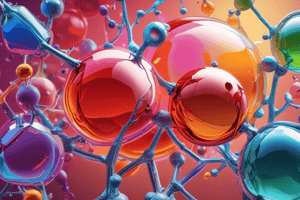Podcast
Questions and Answers
What type of group is bonded to an alkyl carbon in alcohols?
What type of group is bonded to an alkyl carbon in alcohols?
- hydroxyl (-OH) group (correct)
- alkyl (-R) group
- amino (-NH2) group
- carbonyl (-CO) group
Which of the following compounds is a secondary alcohol?
Which of the following compounds is a secondary alcohol?
- isopropanol (correct)
- phenol
- ethanol
- isobutanol
What is the reagent used for Chromic acid tests?
What is the reagent used for Chromic acid tests?
- FeCl3
- HCl/ ZnCl
- NaOH and KMnO4
- H2CrO4 (correct)
What is the result of a tertiary alcohol in a Chromic acid test?
What is the result of a tertiary alcohol in a Chromic acid test?
Which of the following compounds will produce a ketone in a Chromic acid test?
Which of the following compounds will produce a ketone in a Chromic acid test?
What is the reagent used for Lucas's test?
What is the reagent used for Lucas's test?
Which of the following alcohols will give a positive result on chromic acid test but not in Lucas's test?
Which of the following alcohols will give a positive result on chromic acid test but not in Lucas's test?
Why does the Lucas test react quickly with certain alcohols?
Why does the Lucas test react quickly with certain alcohols?
Which of the following groups is directly bonded to the benzene ring in phenols?
Which of the following groups is directly bonded to the benzene ring in phenols?
Why are phenols not considered aromatic alcohols?
Why are phenols not considered aromatic alcohols?
Which of the following compounds react immediately to the Lucas reagent to form an immiscible upper layer of alkyl chloride?
Which of the following compounds react immediately to the Lucas reagent to form an immiscible upper layer of alkyl chloride?
Which of the following is NOT a phenolic compound?
Which of the following is NOT a phenolic compound?
Which of the following is TRUE about phenols?
Which of the following is TRUE about phenols?
Which of the following is the conjugate base of phenol?
Which of the following is the conjugate base of phenol?
Phenols readily react with which of the following compounds to produce a ferric phenoxide salt?
Phenols readily react with which of the following compounds to produce a ferric phenoxide salt?
What is the color of the ferric phenoxide salt that confirms the presence of a phenol?
What is the color of the ferric phenoxide salt that confirms the presence of a phenol?
What type of bond is typically found in saturated hydrocarbons?
What type of bond is typically found in saturated hydrocarbons?
Which of the following chemicals is used in the Chromic Acid Test to distinguish between aldehydes and ketones?
Which of the following chemicals is used in the Chromic Acid Test to distinguish between aldehydes and ketones?
What type of reaction occurs when phenol undergoes an ignition test?
What type of reaction occurs when phenol undergoes an ignition test?
Which of the following is an example of a secondary alcohol?
Which of the following is an example of a secondary alcohol?
What is the reagent used in Lucas Test to distinguish between primary, secondary, and tertiary alcohols?
What is the reagent used in Lucas Test to distinguish between primary, secondary, and tertiary alcohols?
Which of the following compounds is NOT an unsaturated hydrocarbon?
Which of the following compounds is NOT an unsaturated hydrocarbon?
What type of bond is involved in the characteristic reactions of unsaturated hydrocarbons?
What type of bond is involved in the characteristic reactions of unsaturated hydrocarbons?
Which of the following is a characteristic of phenols?
Which of the following is a characteristic of phenols?
Flashcards are hidden until you start studying
Study Notes
Hydrocarbons, Alcohols, and Phenols
Types of Hydrocarbons
- Saturated hydrocarbons: contain only sigma bonds
- Unsaturated hydrocarbons: contain pi bonds
- Aromatic hydrocarbons: contain a planar, cyclic ring with alternating double bonds
Characteristics of Saturated Hydrocarbons
- Contain only sigma bonds
- Do not react with chemicals like KMnO4 and Na2Cr2O7 at room temperature
- Examples: isopentane
Characteristics of Unsaturated Hydrocarbons
- Contain pi bonds
- React with chemicals like KMnO4 and Na2Cr2O7
- Examples: alkenes (e.g., 2-pentene), alkynes (e.g., 1-pentyne), cycloalkenes
Characteristics of Aromatic Hydrocarbons
- Contain a planar, cyclic ring with alternating double bonds
- Do not react with chemicals like KMnO4 and Na2Cr2O7 at room temperature
- Examples: benzene
Alcohols
- Contain a hydroxyl (-OH) group bonded to an alkyl carbon
- Can be primary, secondary, or tertiary
Primary Alcohols
- React with Lucas reagent to form an immiscible upper layer of alkyl chloride
- Examples: ethanol
Secondary Alcohols
- React with Lucas reagent to form an immiscible upper layer of alkyl chloride
- Examples: isopropanol
Tertiary Alcohols
- Do not react with Lucas reagent
- Examples: isobutanol
Phenols
- Contain a hydroxyl (-OH) group bonded to an aromatic ring
- Are more acidic than alcohols
- React with FeCl3 to produce a ferric phenoxide salt
- Examples: phenol, thymol, catechol
Baeyer's Test
- A method for detecting unsaturation in hydrocarbons
- Reagents: KMnO4
- Produces a brown MnO2 precipitate
Chromic Acid Test
- A method for detecting aldehydes and ketones
- Reagents: H2CrO4
- Tertiary alcohols do not react
- Primary and secondary alcohols react to form a ketone or carboxylic acid
Lucas's Test
- A method for detecting alcohols
- Reagents: HCl/ ZnCl
- Primary alcohols react immediately with Lucas reagent to form an immiscible upper layer of alkyl chloride
- Secondary and tertiary alcohols react more slowly
Studying That Suits You
Use AI to generate personalized quizzes and flashcards to suit your learning preferences.




